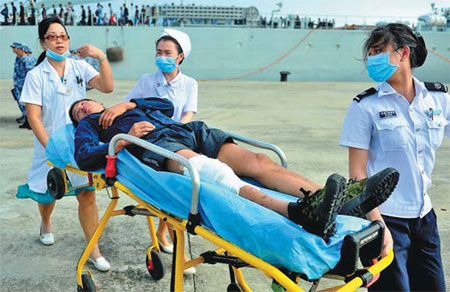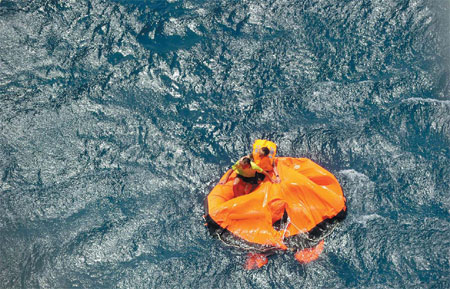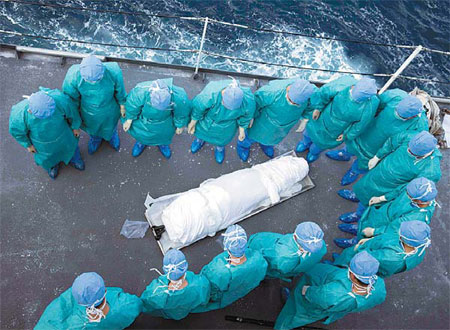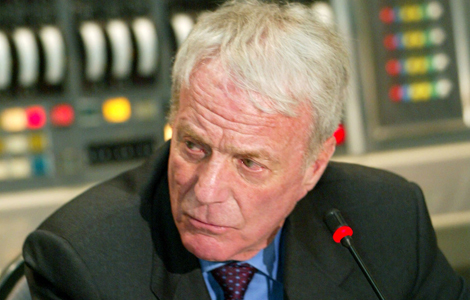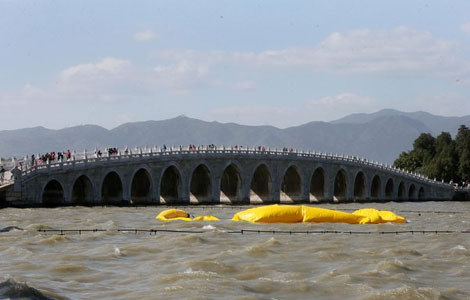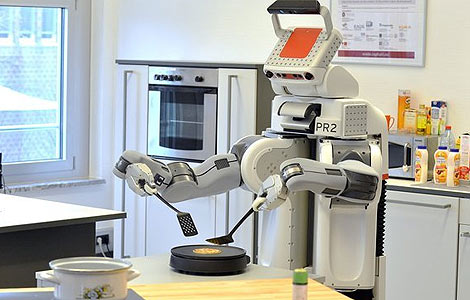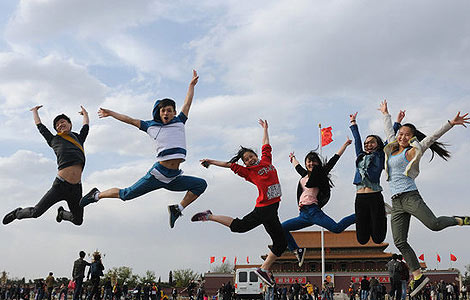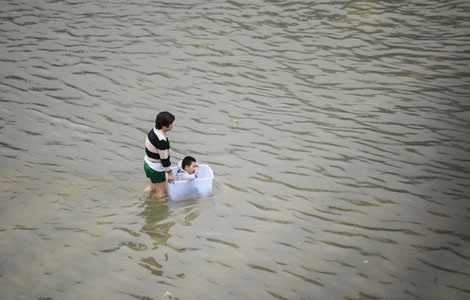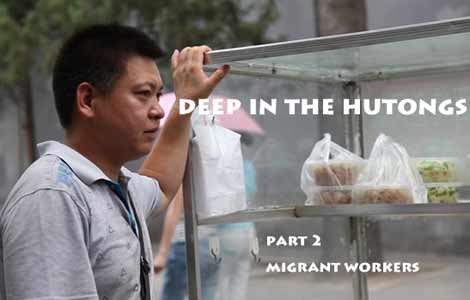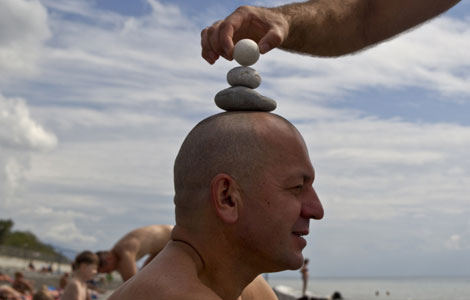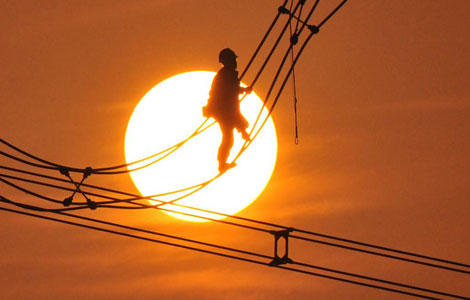Making a di erence at home and abroad
Updated: 2013-10-11 07:22
By Peng Yining in Hainan and He Na, Jiang Xueqing and Wu Wencong in Beijing (China Daily)
|
||||||||
Unprecedented efforts to save lives in the South China Sea, report Peng Yining in Hainan and He Na, Jiang Xueqing and Wu Wencong in Beijing.
Editor's note: On June 10, the Peace Ark embarked on a 118-day voyage to provide medical assistance in a number of countries and take part in joint operations and exercises with fellow members of ASEAN. This is the last report by China Daily's Peng Yining.
Lei Jie rappelled down a line from a helicopter to reach a fisherman who was floating in the ocean, but he was unable to get close enough.
The 34-year-old sailor later dropped into the water and tried to swim toward the man, but "I was trapped in the current," he said.
"I could see him a couple of meters away, wearing black rubber coveralls, floating face down and with his limbs splayed. I wanted to drag him to a life raft, but I couldn't get any closer."
The man was later pulled from the water by another Peace Ark rescue team, but he had died long before he was spotted.
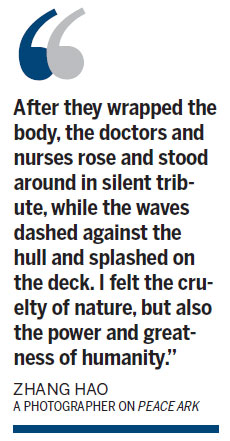
On Sept 29, Typhoon Wutip hit the South China Sea, sinking three fishing boats from Guangdong province carrying 88 people. Fourteen fishermen are known to have died in the storm, 26 were rescued and 48 are still missing, according to the emergency command center of Hainan province.
As Wutip tore across southern China, President Xi Jinping ordered the governments of Hainan and Guangdong to make every effort to search for and rescue the stranded, limit injuries and help the relatives of the victims.
Premier Li Keqiang also instructed government departments to cooperate closely and ensure the safety of rescue workers.
By Sunday, the Hainan Maritime Safety Administration had coordinated 175 rescue ships and naval vessels and 47 aircraft to participate in the mission. Rescue workers searched for survivors across 136,100 square kilometers of ocean and 165,600 sq km of airspace.
The mission in the Xisha Islands was unprecedented in the South China Sea in terms of scale and the resources invested, said Xu Yun, deputy secretary-general of the Hainan provincial government. It not only demonstrated a people-oriented philosophy, but also showed that China's comprehensive national power has increased and its marine rescue operations are world class, he said.
In addition to sinking the three boats from Guangdong, Wutip also destroyed 33 fishing boats and a merchant ship from Hainan, sank four fishing boats and stranded 28 boats and ships. More than 520 people in immediate danger were quickly evacuated to Sanya city.
Xiao Changyi, a 46-year-old fisherman from Hainan, said he abandoned his trip as soon as the alarm was sounded. "It was a close call. The storm was tossing the boat around and the seas were extremely heavy," he said. "Fishing is dangerous work. I'm grateful that the government has paid such close attention to rescue work and our safety. It makes me feel safer and more confident at sea."
Chen Seyan, a 53-year-old fisherman who was pulled from the water told China Communications News: "Suddenly my mind went blank when I fell from the boat. I thought my life was definitely over. I came round after a while and found I was floating on the surface of the water, clinging onto a piece of the sampan, I knew someone would come to my aid and I want to thank the search and rescue staff that gave me a new life," he said.
Some rescued fishermen displayed placards at Sanya port reading: "Thank you! The army made up of the sons of the People. Thanks for your hard work!"
A race against time
Zhao Weilun, vice-director of the helicopter crew on the Peace Ark, said, "The disaster had been ongoing for four days when we joined the rescue operation on Oct 3. Although there was little hope by then, we gave 100 percent effort."
More than 400 members of the crew took turns scanning the surface of the ocean, and the helicopter circled repeatedly over key areas. It was a race against time. Each new discovery caused tremendous excitement and sometimes the search process was an emotional roller coaster. After two hours of searching from the helicopter, Lei discerned something orange floating in the water. "It could have been a person wearing a life vest, so everyone on the helicopter was excited. Sadly, it just turned out to be life vest," he said.
Lei was also sent to search a stranded fishing boat. "I walked up to the boat along a coral reef. The water was up to my neck," he said. "I climbed aboard, but found nothing."
After searching the waters for five days, Peace Ark found five bodies and took charge of five others that had been transferred from other search vessels.
As China's largest hospital ship, Peace Ark's crew includes more than 100 medical professionals. When the first body was discovered on Oct 3, 15 medical staff donned protective clothing and helped to receive the dead fisherman. They cleaned the body, sealed up the dead man's belongings, including a watch and a necklace, and preserved some tissue as a specimen before finally wrapping the body in a white cloth.
"After they wrapped the body, the doctors and nurses rose and stood around in silent tribute, while the waves dashed against the hull and splashed on the deck," said Zhang Hao, a photographer on the ship. "I felt the cruelty of nature, but also the power and greatness of humanity."
After soaking in the briny water for a couple of days, many of the bodies were swollen, and the skin was peeling off some of them. We saw many other details that are too distressing to report.
Although the Peace Ark didn't locate any survivors, it helped to protect the dignity of the dead by preserving their remains, said Wu Haibo, the ship's head nurse, who also participated in the rescue efforts after the 2008 Sichuan earthquake.
"I was so sad to see the people who died in the typhoon," she said. "After I had wrapped up the bodies, I said to myself 'Let's take them home'."
Close cooperation
In addition to naval rescue forces and those from government departments on the Chinese mainland, the government of the Hong Kong Special Administrative Region sent a Jetstream 41 aircraft to help in the operation. It was the first time a search and rescue aircraft from Hong Kong had been allowed to fly over the Xisha Islands on a rescue mission, according to China Communication News.
"On previous rescue missions, the military ships, boats and aircraft were unable to communicate directly with those of the government, which caused some problems. However, during this mission in the South China Sea we had real-time communication with all parties in the operation through the Automatic Identification System and the Beidou Navigation Satellite System. It made the joint effort highly efficient and scientific," said Ruan Ruiwen, head of Hainan Maritime Safety Administration.
One of the reasons Wutip caused so many deaths was that it changed course as it roared across the ocean, according to Huang Zuoping, a senior official from the South China Sea Fishery and Fishing Port Administration Bureau of the Ministry of Agriculture.
Usually, typhoons in the South China Sea head west or northwest after forming, but on this occasion the storm headed southwest, which even experienced fishermen failed to predict.
The local government issued more than 10 warnings to fishing boats in the hope of alerting them before they were caught by the typhoon, but some crews told us it was already too late for them to shy away. Some didn't even have time to start the lifesaving equipment on their boats, according to Huang.
"The incident is a lesson paid for with blood, both for the fishery administration departments and the fishermen. It relates especially to areas such as weather forecasting and the issuance of early warnings. We will continue to investigate the reasons and make a report when the search has been completed," he said.
Destructive power
Lin Dasheng, 30, a fisherman from Qiongtou village in Xiamen, Fujian province, was also affected by the typhoon.
"Although our village is far from the South China Sea where the boats sank, my attention is still closely focused on the rescue efforts there," Lin said.
"The more sunken boats I heard about, the stronger my desire to quit the profession became. My parents hope I will. They told me they can't eat or sleep well when I am out fishing," he said.
According to Lin, in recent years typhoons, the largest threat to fishermen, have become more frequent and their destructive power has increased.
"As the circumstances have changed, our awareness of typhoons has also risen, especially after the painful lesson of 1999 when a typhoon hit Xiamen directly. The landfall wrought huge damage in the coastal villages and many parts of Xiamen's downtown area were submerged," he said.
"Typhoon warnings and the safety of fishermen drew great attention to local government after the disaster. But, all the boats have to be checked and insured every year, so the local government utilizes various channels, including village committees and the border police, to release timely information and warnings," he added.
Every fishing boat is equipped with a waterproof mobile phone fitted with a GPS receiver, which enables rescue staff to quickly pinpoint the exact location of every boat in the event of an emergency.
"The GPS phone is very helpful. One of our villagers had a heart attack out at sea, but he was saved with the help of the phone," said Lin.
In addition, the local government organized safety training for many of the fishermen, and safety pamphlets are issued to every boat.
"Nothing is more precious than life. If the fishermen in the South China Sea area can return to port right after they receive a typhoon warning and nothing is left to chance, then more of them may have a chance of staying alive," Lin said.
Contact the writer at pengyining@chinadaily.com.cn
Zhang Hao contributed to this story.
|
An injured fisherman is rushed to hospital in Sanya, Hainan province, on Oct 3. As Typhoon Wutip hit the South China Sea late last month, sinking fishing boats, China mobilized massive resources in its largest rescue mission in the sea. Zhang Yongfeng / Xinhua |
|
Two fishermen in a life raft await rescue on Oct 1 after their fishing boat was destroyed by Typhoon Wutip, which hit the South China Sea on Sept 29. The storm resulted in 14 deaths and 48 people are still missing. Twenty-six people had been rescued by Oct 8. Zhao Yingquan / Xinhua |
|
Doctors and nurses stand around a body in silent tribute on the Peace Ark. Zhang Hao / for China Daily |

(China Daily USA 10/11/2013 page6)
Most Viewed
Editor's Picks

|

|

|

|

|

|
Today's Top News
Opportunity knocks for US businesses
KFC needs new faces, not new ad campaign
China's growth rate to exceed 7.5%
US woos Malaysia in TPP talks
Nobel literature winner's work snubbed in China
Trending news across China on Oct 11
Xi ignites Australia's zeal for FTA deal
Fire at Fukuoka hospital leaves 10 dead
US Weekly

|

|
